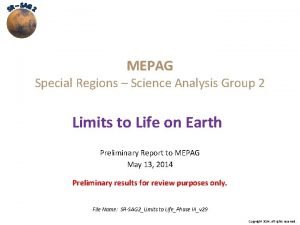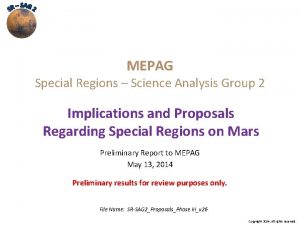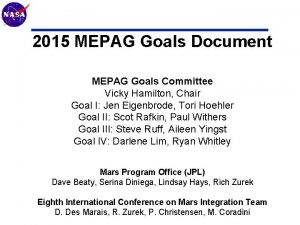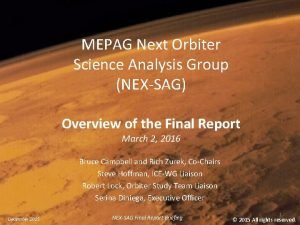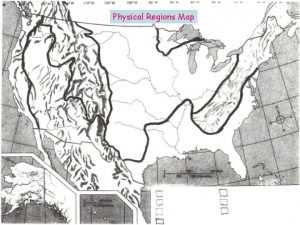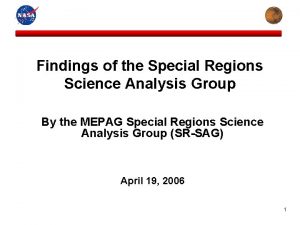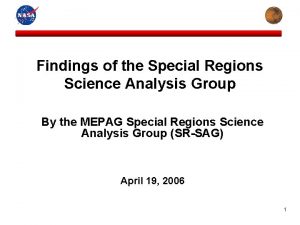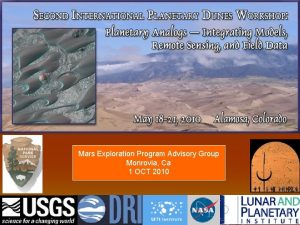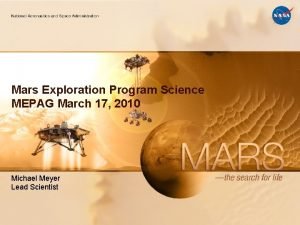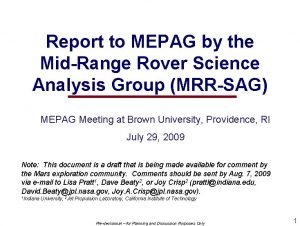MEPAG Special Regions Science Analysis Group 2 Special


















- Slides: 18

MEPAG Special Regions – Science Analysis Group 2 Special Regions and the Human Exploration of Mars Preliminary Report to MEPAG May 13, 2014 Preliminary results for review purposes only. File Name: SR-SAG 2_Human Explorers_Phase III_v 15 Copyright 2014. All rights reserved.

Human Exploration of Mars and Special Regions • • • Human exploration of Mars requires access to resources, including • Water • Oxygen • Protection from radiation • Fuel for vehicles These resources are available on Mars and will require access to surface or near-subsurface materials, some of which may be found in Special Regions are in part defined on the availability of water, making them a potential source of water and oxygen, in addition to their science value Protocols need to be established so that human activities do not inadvertently affect areas designated as Special Regions or cause non-Special Regions to become Special. • 9/9/2020 The spread of terrestrial biological contamination could also impact life support systems, and the availability of Mars resources to human explorers. Special Regions - Science Analysis Group 2 Preliminary results for review purposes only. 2

Water Resources • Polar caps (poleward of ~80 latitude) • Seasonal caps are CO 2 ice. • Permanent south polar cap is H 2 O covered by ~8 m thick veneer of CO 2 ice. • Permanent north polar cap is H 2 O ice North polar cap • ~3 km thick, 1100 -km diameter • Volume estimated between 1. 1 and 2. 3 x 106 km 3. Freshwater content estimated to be ~100 x the amount in North American Great Lakes. • Ice accessible at surface • Estimated to be 90 -100 wt% H 2 O, mixed with dust from global dust storms • Polar caps are not considered to be Special Regions unless heated to melting • Accessibility Limitations: Polar night darkness and cold limit useful season; CO 2 degassing in area may affect safe access by human explorers 9/9/2020 Special Regions - Science Analysis Group 2 Preliminary results for review purposes only. 3

Water Resources • High Latitudes (60 - 80 latitude) • Region largely covered by seasonal caps during winter season • As seasonal caps retreat in spring, frost outliers (both CO 2 and H 2 O) are left behind • Region surrounding north polar cap largely comprises Ice and frost in 35 km diameter crater at 70 N the Vastitas Borealis Formation, interpreted as composed of ice-rich fine-grained (dust) deposits and ice-rich sediments from ancient fluvial activity. • Ice-rich fine-grained deposits also seen surrounding south polar cap, but much thinner than in north. • Geomorphic features in this region suggest ice-rich flow associated with glacial activity both today and in past • New fresh impacts in this region expose ice excavated from depths ranging from 0. 3 m to 1. 7 m. • Not considered to be Special Regions unless heated to melting • Accessibility Limitations: Same as polar caps 9/9/2020 Special Regions - Science Analysis Group 2 Preliminary results for review purposes only. 4

Water Resources • Mid-Latitudes (30 -60 latitude) • Geomorphic evidence of ice-related features emplaced during period of high axial tilt. • Geomorphic evidence of features produced by possible fluvial activity in past (gullies, layered deposits in craters, etc. ) • Recurrent Slope Lineae (RSL) activity concentrated in this zone, particularly in southern hemisphere. • Fresh impacts expose ice excavated from 0. 3 -2. 0 meters depth. • Region where ice deposition can occur • during periods of high axial tilt • RSL sites are treated as Special Regions. Other regions in this zone not considered to be Special unless heated to melting or some future observation points to the natural presence of water. • Accessibility limitations: Energy • produced by solar power limited to • summer season Distribution of confirmed RSLs. 9/9/2020 Special Regions - Science Analysis Group 2 Preliminary results for review purposes only. 5

Water Resources • Equatorial Region (between 30 S and 30 N) • RSL sites and potential active gullies suggest presence • of near-surface liquid in certain locations. • Ice deposits from past periods of high axial tilt remain at depth (>15 m) in localized regions, such as northwest of the Tharsis volcanoes. • Areas of H 2 O enhancement (from Mars Odyssey • neutron analysis) within equatorial region are usually • interpreted as being due to hydrated minerals, which Tropical glacier deposits • may contain water contents up to ~13%. along Tharsis volcanoes • Impact crater analysis, radar data, and neutron • spectrometer data suggest that subsurface is generally located at depths >5 m in this region and often >50 m depth. • RSL sites and possibly the active gullies are Special Regions. Other locations are not Special. • Accessibility limitations: High levels of solar energy and warmest temperatures on the planet, but limited accessibility to H 2 O. 9/9/2020 Special Regions - Science Analysis Group 2 Preliminary results for review purposes only. 6

Preliminary Map of Features of Relevance to Interpreting Special Regions on Mars SR-SAG 2 May 1, 2014 Background colors represent topography from MOLA. 9/9/2020 Special Regions - Science Analysis Group 2 Preliminary results for review purposes only. 7

Water/Oxygen ISRU • Atmosphere • Water vapor varies seasonally but overall is small amount compared to surface resources. Condensation of all H 2 O vapor in atmosphere would produce ~1 km 3 of liquid. • Martian atmosphere consists of mostly CO 2, which can be utilized to produce oxygen; water is found in Martian regolith materials. • Limitations: Energy to run CO 2 electrolysis systems, regolith baking ovens and water vapor condensers; Dust in Martian atmosphere, particularly during dust storm periods, could clog atmospheric ISRU. H 2 O clouds in pre-dawn sky from Mars Pathfinder 9/9/2020 Martian dust devil seen from orbit Special Regions - Science Analysis Group 2 Preliminary results for review purposes only. 8

Water/Oxygen ISRU • Surface resources • Surface and near-surface (<3 m depth) ice deposits could provide H 2 O and O 2 9/9/2020 Special Regions - Science Analysis Group 2 Preliminary results for review purposes only. 9

Water/Oxygen ISRU • Surface resources • Hydrated minerals (phyllosilicates, sulfates, and carbonates) in localized regions could be used to extract H 2 O and O 2. Chlorides are largely anhydrous. Elhmann and Edwards (2014) Annu. Rev. Earth Planet. Sci. 42: 291– 315 9/9/2020 Special Regions - Science Analysis Group 2 Preliminary results for review purposes only. 10

Water/Oxygen ISRU • Perchlorate • • • 9/9/2020 Perchlorate (Cl. O 4 -) has been detected at Phoenix and MSL landing sites (Hecht et al. , 2009; Glavin et al. , 2013) and in one martian meteorite (Kounaves et al. , 2014). Expected to be common in Martian regolith across planet. Perchlorate and chlorides could be a source of ISRU-derived O 2 or propellants (Davila et al. , 2013). However, perchlorate is toxic to humans. Presence in dust, groundwater, and in crops grown in Martian soil needs to be reduced for human activities to be successfully conducted on Mars (Davila et al. , 2013). Special Regions - Science Analysis Group 2 Preliminary results for review purposes only. 11

Radiation Environment • • The thin atmosphere, small concentrations of atmospheric ozone, and lack of a present-day active magnetic field result in radiation reaching the martian surface from space. The Radiation Assessment Detector (RAD) on the Mars Science Laboratory’s Curiosity rover has measured galactic cosmic ray (GCR) and solar energetic particle (SEP) doses at the surface (Hassler et al. , 2014). 9/9/2020 Depth (m) GCR Equivalents (m. Sv/yr) GCR Dose Rate (m. Gy / yr) 0 232 76 0. 1 295 96 1 81 36. 4 2 15 8. 7 3 3 1. 8 Special Regions - Science Analysis Group 2 Preliminary results for review purposes only. 12

Radiation Shielding • • A round trip Mars surface mission of 360 -day round -trip (180 day each way) cruise and 500 days on the surface is estimated to result in a total mission dose equivalent of ~1. 01 Sv, based on MSL cruise and surface radiation measurements (Hassler et al. , 2014). Doses could be higher if operations occur during periods of higher solar activity. Current federal occupational limit of radiation exposure per year for an adult is below ~0. 05 Sv. Thus shielding is required for long-term surface operations. Collapsed pits associated with extensional tectonics, northeast of Arsia Mons. Images: NASA/JPL/University of Arizona. Composited by G. Cushing. • Deposition of regolith over surface habitats, water storage both in tanks and as ice around habitats, or erection of habitats underground (perhaps in lava tubes/caves) would provide the necessary shielding from radiation. • Remnant crustal magnetism in a few locations in the highlands may provide some partial shielding from cosmic radiation. 9/9/2020 Special Regions - Science Analysis Group 2 Preliminary results for review purposes only. 13

Fuel and Power Sources • • Fuel for surface operations and/or propellants for crew ascent to orbit could be manufactured from Mars surface materials. Hydrogen, oxygen, and methane could be produced from atmospheric CO 2 or atmospheric/surface H 2 O (electrolysis and Sabatier process). O 2 could be produced from surface perchlorate. Surface metals such as Mg or Al may also be useful as propellants. Power for daily operations is expected to be produced from solar energy and/or RTGs. • Reliance on solar energy will limit operations to the equatorial zone, where near-surface/surficial ice resources are limited. • Power from RTGs would allow surface operations at a range of latitudes, but heat produced from this source could result in some current non-Special Regions becoming Special. Surface nuclear power reactors would allow greater freedom in accessing nonequatorial resources but waste heat from these facilities also could result in the creation of Special Regions in areas which are not currently classified as Special. 9/9/2020 Special Regions - Science Analysis Group 2 Preliminary results for review purposes only. 14

Limiting Contamination of Special Regions by Human Activities • It will be not be possible for all human-associated processes and mission operations to be conducted within entirely closed systems. • Human missions to Mars shall not affect or otherwise contaminate Special Regions of Mars, nor be contaminated by materials from them. • Human activities on the surface of Mars shall avoid converting areas into Special Regions, such as through the melting of surface/near-surface ice by waste heat. • One scenario: establish “safe zone” for human activities near Special Regions, but allow controlled robotic access to the Special Region locations, themselves, as depicted on the next slide, which implies: – – 9/9/2020 Ability to land a “clean” robotic rover in the same area as the human landing site System capability to aseptically interact with rover and receive contained, rovercollected samples. Special Regions - Science Analysis Group 2 Preliminary results for review purposes only. 15

Safe Zone for “Safe Zone” Human from precursors (may Activities be entire planet) 2 b, 3 “Life Sites” defined from remote sensing data Unexplored Hypothetical Special Region/Potential SR Human Habitats Assay #2 Lab Hab Robotic/Teleoperation Human Traverse Assay #1 Clean Rover Site Hypothetical Special Region with Robotic Exploration

Summary of Resources and Relationship to Special Regions Resource/Activity Sources Special Region Concerns H 2 O Resources Surface and near-surface ISRU Atmosphere, H 2 O deposits, Same as for H 2 O Resources. hydrated minerals, perchlorate Radiation Shielding Regolith and/or water over habitat; underground (caves/lava tubes). Fuel and Power Atmosphere, surface materials, May become Special if perchlorates, solar energy, surface/subsurface is nuclear power heated to melting. 9/9/2020 Special Regions - Science Analysis Group 2 Preliminary results for review purposes only. RSL sites and possibly active equatorial gullies are treated as Special Regions. Other regions may become special if ice is heated to melting. Natural caves/lava tubes may be Special Regions. 17

References Davila, A. F. , Willson, D. , Coates, J. D. , and Mc. Kay, C. P. (2013), Perchlorate on Mars: A chemical hazard and a resource for humans. Intern. Journal of Astrobiology, 12(4), 321 -325. Glavin, D. P. , Freissinet, C. , Miller, K. E. , Eigenbrode, J. L. , Brunner, A. E. , Buch, A. , Sutter, B. , Archer, P. D. , Atreya, S. K. , Brinckerhoff, W. B. , Cabane, M. , Coll, P. , Conrad, P. G. , Coscia, D. , Dworkin, J. P. , Franz, H. B. , Grotzinger, J. P. , Leshin, L. A. , Martin, M. G. , Mc. Kay, C. , Ming, D. W. , Navarro-González, R. , Pavlov, A. , Steele, A. , Summons, R. E. , Szopa, C. , Teinturier, S. , and Mahaffy, P. R. (2013), Evidence for perchlorates and the origin of chlorinated hydrocarbons detected by SAM at the Rocknest aeolian deposit in Gale crater. J. Geophysical Research, 118 (10), 1955 -1973. Hassler, D. M. , Zeitlin, C. , Wimmer-Schwingruber, R. F. , Ehresmann, B. , Rafkin, S. , Eigenbrode, J. L. , Brinza, D. E. , Weigle, G. , Böttcher, S. , Böhm, E. , Burmeister, S. , Guo, J. , Köhler, J. , Martin, C. , Reitz, G. , Cucinotta, F. A. , Kim, M. -H. , Grinspoon, D. , Bullock, M. A. , Posner, A. , Gómez-Elvira, J. , Vasavada, A. , Grotzinger, J. P. , and MSL Science Team (2014), Mars’ surface radiation environment measured with the Mars Science Laboratory’s Curiosity Rover. Science, 343, Hecht, M. H. , Kounaves, S. P. , Quinn, R. C. , West, S. J. , Young, S. M. M. , Ming, D. W. , Catling, D. C. , Clark, B. C. , Boynton, W. V. , Hoffman, J. , De. Flores, L. P. , Gospodinova, K. , Kapit, J. , and Smith, P. H. (2009), Detection of perchlorate and the soluble chemistry of Martian soil at the Phoenix lander site. Science, 325 (5936), 64 -67. Kounaves, S. P. , Carrier, B. L. , O’Neil, G. D. , Stroble, S. T. , and Claire, M. W. (2014), Evidence of Martian perchlorate, and nitrate in Mars meteorite EETA 79001: Implications for oxidants and organics. Icarus, 229, 206 -231. 9/9/2020 Special Regions - Science Analysis Group 2 Preliminary results for review purposes only. 18
 Nina's favorite subject is science
Nina's favorite subject is science Dance that is performed during wedding feast
Dance that is performed during wedding feast Ap psychology chapter 13
Ap psychology chapter 13 Y = a(b)^x
Y = a(b)^x Anova within group and between group
Anova within group and between group Definition of social group
Definition of social group Joint royal college of physicians training board
Joint royal college of physicians training board Group 2 nitrates thermal stability
Group 2 nitrates thermal stability Amino group and carboxyl group
Amino group and carboxyl group Amino group and carboxyl group
Amino group and carboxyl group In group out group
In group out group Group yourself or group yourselves
Group yourself or group yourselves Sumner's classification of social groups
Sumner's classification of social groups Joining together group theory and group skills
Joining together group theory and group skills Social science vs natural science
Social science vs natural science Natural science branches
Natural science branches Natural science vs physical science
Natural science vs physical science Applied science vs pure science
Applied science vs pure science Natural science and social science similarities
Natural science and social science similarities



















